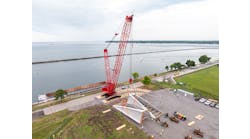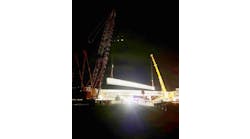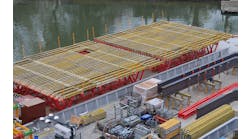By: Allen Zeyher
Earthquakes have not gotten bigger since Dumbarton Bridge opened in 1982, but the science of earthquakes has advanced greatly.
A recent review of earthquakes of the past thousand years led engineers at the California Department of Transportation (Caltrans) to think that Dumbarton Bridge needed to
be strengthened.
The investigators prescribed more robust seismic bearings along the steel main-span section of the bridge. Before the new bearings could be installed, though, the main span had to be jacked up 5 in., because the bearings were thicker than the previous ones. Before the span could be jacked up, it had to be reinforced. The seismic retrofit project also includes replacing major deck joints.
Dumbarton Bridge, part of the San Francisco Bay Area Toll Bridge Seismic Retrofit Program, consists of five main sections: a main span at the middle of the bridge, an approach structure at each end of the main crossing and a trestle structure at the far end of each approach structure. The existing structure is 1.6 miles long and connects the cities of Menlo Park and Fremont, Calif. The bridge serves about 61,000 vehicles per day and carries three lanes of traffic in each direction.
Dumbarton is the southernmost of the highway bridges across the San Francisco Bay. It was originally constructed by private developers in 1927. The state of California bought the bridge in 1951 for $2.26 million and rebuilt it in 1982 at a cost of $70 million.
The current retrofit is contracted to Shimmick Construction Co. Inc., based in Oakland, Calif. The Toll Bridge Program Oversight Committee consists of Caltrans, the Bay Area Toll Authority and the California Transportation Commission.
Shaking up the design criteria
“Every time we have an earthquake, we go out there and we study the impact of that earthquake on our design standards and how each structure behaved due to that earthquake,” Amer Bata, Caltrans area construction manager on the Dumbarton Bridge Seismic Retrofit, told Roads & Bridges. “Our engineers re-evaluated the latest findings from the latest earthquakes we had worldwide and determined what each bridge may need, and then they studied the existing bridge behavior, and based on that behavior they recommend a certain design criteria or a certain improvement to make sure it will withstand the next big event.”
The engineers decided the bridge needed to be able to move as much as 42 in. in response to an earthquake to prevent damage to the pier columns and footings. Previously, the bridge was capable of 20 in. of lateral movement.
The contractor is installing friction pendulum bearings designed by Earthquake Protection Systems Inc., Vallejo, Calif., to isolate the superstructure from the piers. They also have to upgrade the two major seismic joints at Pier 16 and Pier 31 to accommodate the increased freedom of lateral movement.
Pier 16 and Pier 31 are where the main span meets the approach structures. The main span will be raised 5 in., but the approach spans will not. To ease the transition, they are placing a concrete taper from the joint, where the approach span meets the 5-in.-higher main span, to a point 96 ft down the approach span.
“Most drivers can’t even feel the rise that we did at Pier 16,” Bata said. “When we finished the work, hardly anybody noticed that there was any difference in the ride.”
Most drivers don’t notice the work to install the friction pendulum bearings either. That work has been going on day and night since 2010, according to Effie Milionis, communications manager for the Toll Bridge Seismic Safety Retrofit Projects.
Escape hatch
“The contractor has been really good about staying out of the way of the motoring public,” Milionis told Roads & Bridges. “Caltrans has come up with a way to put dozens of access hatches on the deck, so that when those lanes are closed, workers can open up the hatches, go inside the steel tub and work inside the deck or even unload and pass equipment and materials over the side of the bridge.”
Each bearing consists of an upper plate, a lower plate and a sort of puck pressed between them. The surfaces that make contact with each other are extremely smooth, so they will slide against each other and absorb the lateral motions of an earthquake.
“The surface that they came up with is amazing,” Bata said. “We did a special test down at the University of San Diego,” with nine full-size bearings under the loads they were likely to be subjected to in service on the bridge. “We just kept moving them back and forth. We tested them for a few days to make sure everything worked and they wouldn’t scratch. Everything came up to be great.”
High and dry
All of the retrofit work was done without stationing any equipment in the water under the bridge. Dumbarton Bridge is within the Don Edwards San Francisco Bay National Wildlife Refuge, according to http://dumbartonbridgeinfo.org, and traverses a particularly fragile slice of the ecosystem. The seismic retrofit project required certain environmental mitigation measures and a storm-water pollution prevention plan.
“The actual water under Dumbarton Bridge is very shallow,” Bata said, “so to do the work from the water using barges or boats would require a lot of dredging, and whenever you do dredging you’re going to increase the turbidity. . . . It was decided it would be much easier and much better for the environment to do the work on the bridge from land and from the top of the bridge without any use of dredging.”
The substructure needed some reinforcement also. The height of the footings of Piers 17 through 30 was increasing by adding a foot of concrete on top. Two feet of concrete and steel were added to each side of the pier caps between Piers 16 and 31.
The interior cells of the main spans between Piers 16 and 31 were reinforced with structural-steel jacking frames.
To raise the main spans, they are working in increments. No section can be more than 1 in. higher than its neighboring sections, so if Pier 20 is jacked up 5 in., Piers 19 and 21 have to be jacked up 4 in., Piers 18 and 22 have to be jacked up 3 in., Piers 17 and 23 have to be jacked up 2 in. and Piers 16 and 24 have to be jacked up 1 in.
They began at Pier 16 and worked their way an inch at a time toward Pier 31, jacking and installing the friction pendulum bearings as they went.
“To raise one pier, you require eight jacks,” Bata said. “We don’t want any pier to be more than 1 in. higher than the adjacent pier. We’re doing it in sequence, so for example when we raise Pier 16 to 5 in., we raise Pier 17 to 4, 18 to 3, 19 to 2 and so on.”
The jacks for a pier are all connected through a manifold, and they work in unison.
Each pier from Pier 16 through 31 will have six bearings between it and the superstructure for a total of 96 bearings. The bearings range from 9.1 to 9.3 ft in diameter and from 9.5 to 10 in. in height. They each weigh 12,000-15,000 lb.
Workers completed the jacking operation and installing seismic joints with a full closure at Pier 31 on Labor Day. That was one of only two full closures of the bridge they needed. The other was over Memorial Day weekend to install the seismic joint at Pier 16 at the other end of the main span.
“These two closures are really the only time we need to shut down the entire bridge,” Milionis said, “because they’re literally cutting across all six lanes and the bike and pedestrian path, so there’s no way for traffic to get around that.”
As of Oct. 16, the retrofit project was 88% complete. All work was scheduled to be complete in early 2013. R&B


